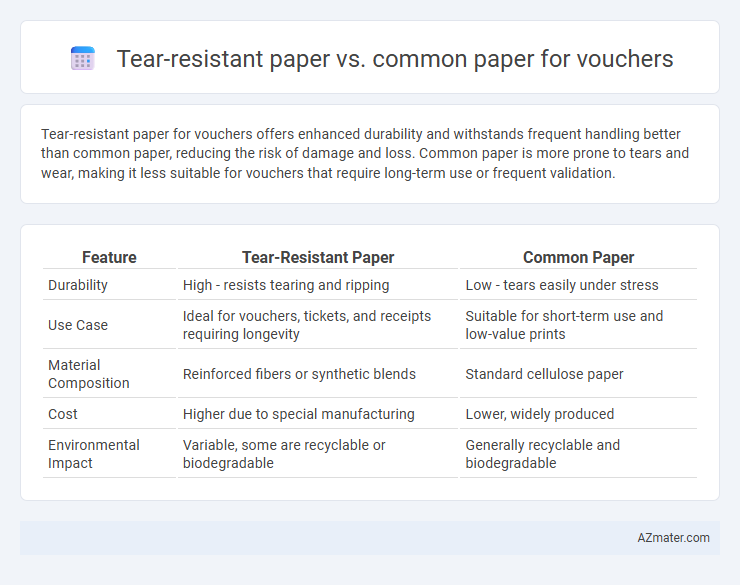Tear-resistant paper for vouchers offers enhanced durability and withstands frequent handling better than common paper, reducing the risk of damage and loss. Common paper is more prone to tears and wear, making it less suitable for vouchers that require long-term use or frequent validation.
Table of Comparison
| Feature | Tear-Resistant Paper | Common Paper |
|---|---|---|
| Durability | High - resists tearing and ripping | Low - tears easily under stress |
| Use Case | Ideal for vouchers, tickets, and receipts requiring longevity | Suitable for short-term use and low-value prints |
| Material Composition | Reinforced fibers or synthetic blends | Standard cellulose paper |
| Cost | Higher due to special manufacturing | Lower, widely produced |
| Environmental Impact | Variable, some are recyclable or biodegradable | Generally recyclable and biodegradable |
Introduction to Voucher Durability Needs
Voucher durability requirements demand materials that withstand frequent handling, exposure to moisture, and wear over time without tearing or degrading. Tear-resistant paper offers enhanced strength and resilience compared to common paper, ensuring that vouchers remain intact during transactions and storage. This durability minimizes the risk of damage-related errors and supports longer validation periods essential for secure financial and retail applications.
What Is Tear-Resistant Paper?
Tear-resistant paper is specially engineered using synthetic fibers or reinforced materials to withstand physical stress and resist ripping, offering durability ideal for vouchers requiring long-lasting quality. Common paper, typically made from wood pulp, has lower tensile strength and is prone to tearing or damage during handling and storage, compromising voucher integrity. The enhanced tear resistance ensures vouchers remain intact through frequent use, improving security and longevity compared to standard paper options.
How Common Paper Performs in Vouchers
Common paper used for vouchers typically lacks durability, often tearing easily during handling or storage. Its lower tensile strength and susceptibility to moisture damage result in frequent wear and reduced voucher lifespan. Consequently, common paper vouchers are less reliable for repeated use or long-term retention compared to tear-resistant alternatives.
Comparing Tear Resistance: A Direct Analysis
Tear-resistant paper outperforms common paper by offering significantly higher durability and resistance to tearing under stress, making it ideal for vouchers that undergo frequent handling. Its specialized fiber composition and reinforced layering provide superior strength compared to the thinner, less resilient fibers found in common paper. This enhanced tear resistance directly reduces voucher damage and increases longevity, ensuring secure and reliable transactions in retail and service environments.
Print Quality on Tear-Resistant vs Common Paper
Tear-resistant paper delivers superior print quality for vouchers, maintaining crisp text and vibrant images even under stress, unlike common paper which often shows ink smudging or fading when torn. The specialized fiber composition in tear-resistant paper ensures consistent ink absorption, resulting in sharper details and longer-lasting print clarity. Common paper tends to degrade quickly, compromising the readability and professional appearance of printed vouchers over time.
Security Features: Which Paper Offers More?
Tear-resistant paper provides enhanced security features compared to common paper, making it ideal for vouchers that require durability and fraud prevention. It often contains embedded fibers, watermarks, and special coatings that resist tampering or unauthorized alterations, which are typically absent in standard paper. Vouchers printed on tear-resistant paper ensure higher protection against forgery, extending both the validity and trustworthiness of the document.
Cost Comparison: Upfront and Long-Term
Tear-resistant paper typically has a higher upfront cost than common paper due to its durable materials and specialized manufacturing process. However, its longer lifespan and reduced need for frequent replacements or reprints make it more cost-effective over time, especially in high-volume voucher printing scenarios. Common paper's lower initial price often leads to increased long-term expenses caused by frequent tearing, reprints, and potential revenue loss from damaged vouchers.
Environmental Impact: Sustainability Factors
Tear-resistant paper for vouchers typically contains synthetic fibers or resin coatings that enhance durability but complicate recycling processes, leading to higher environmental impact compared to common paper made from natural fibers. Common paper is generally more biodegradable and easier to recycle, promoting sustainability through reduced waste and lower resource consumption. Choosing tear-resistant paper requires considering trade-offs between product longevity and end-of-life environmental effects, emphasizing the importance of verifying recyclability certifications.
Use Cases: When to Choose Tear-Resistant Paper
Tear-resistant paper is ideal for vouchers used in environments where durability is crucial, such as retail stores, event tickets, and transportation passes subject to frequent handling or rough conditions. Common paper suits short-term or low-traffic uses like one-time coupons or receipts where durability is less critical. Choosing tear-resistant paper minimizes the risk of damage and ensures vouchers remain intact throughout their validity period.
Conclusion: Choosing the Best Paper for Vouchers
Tear-resistant paper offers superior durability and security compared to common paper, making it ideal for vouchers that require long-lasting use and resistance to tampering. Common paper may be cost-effective but lacks the strength to withstand frequent handling, increasing the risk of damage and fraud. Selecting tear-resistant paper ensures enhanced protection and a professional appearance, crucial for valuable or frequently exchanged vouchers.

Infographic: Tear-resistant paper vs Common paper for Voucher
 azmater.com
azmater.com